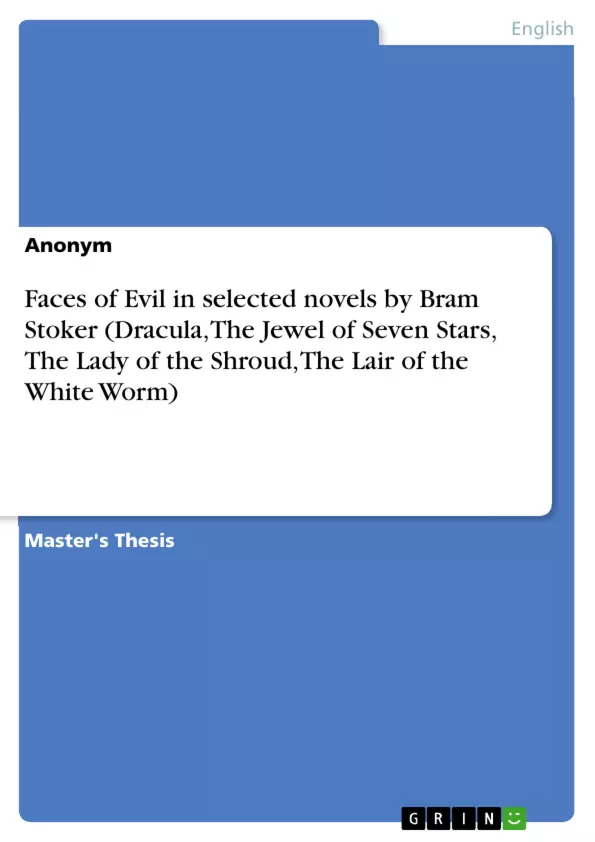The goal of this research is to examine selected works of Bram Stoker (Dracula, The Jewel of Seven Stars, The Lady of the Shroud, The Lair of the White Worm) and examine the presence of elements that are both characteristic of Gothic literature, and unique in the works of Stoker. In order to investigate and present some of Stoker's lesser known works, the analysis is concentrated on the most prominent elements present in his novels, like: the negative impact of the natural environment on the mind and body, the transgression of moral and social boundaries, and the relationship between woman and evil. Prior to a close investigation, each chapter first presents the theory behind each topic, and exemplifies it by giving an overview of prominent literary works that appeared before 1900.
Inhaltsverzeichnis (Table of Contents)
- INTRODUCTION
- CHAPTER ONE: NATURE AND EVIL
- Natural evil and the aesthetic approach
- The influence of the natural and supernatural
- Evil and animals
- CHAPTER TWO: TRANSGRESSIONS
- Crossing the borders of vice and virtue
- Sexual Transgression and Excess
- CHAPTER THREE: MONSTROUS FEMALES AND FEMALE MONSTERS
- The archetype and its origin
- Stoker's monstrous female
- CONCLUSION
Zielsetzung und Themenschwerpunkte (Objectives and Key Themes)
The main objective of this study is to explore and analyze the various ways in which evil is displayed, manifests itself, and effects the characters in Bram Stoker’s Gothic novels: Dracula, Jewel of Seven Stars, The Lady of the Shroud, and Lair of the White Worm.
- The unique characteristics of evil as presented in each novel
- The influence of evil on the main characters in each novel
- The relationship between the representations of evil and other significant works of the Gothic genre
- The manifestation of evil through natural and supernatural factors
- Transgression and excess as ways of manifesting the influence of evil on characters
Zusammenfassung der Kapitel (Chapter Summaries)
Chapter one, “Nature and Evil,” explores how evil is presented through the manifestation of natural and supernatural factors. This chapter utilizes the English aesthetic theories, such as those proposed by Edmund Burke, to understand how sensory perception can create negative mental reactions. The analysis focuses on the textual descriptions of mental and physical responses to “evil” stimulus from the point of view of the characters in the story.
Chapter two, “Transgressions,” examines ideas of transgression and excess as ways of manifesting the influence of evil on the characters in a novel. This chapter utilizes contemporary critics such as Fred Botting and Glennis Byron to define Gothic transgression and excess. The chapter focuses on ideas and emotions such as desire, urge, persuasion, seduction, guilt, and redemption to understand excessive behavior and transgression.
Schlüsselwörter (Keywords)
This study examines the themes of evil, transgression, and monstrosity in the works of Bram Stoker, focusing on the novels Dracula, Jewel of Seven Stars, The Lady of the Shroud, and The Lair of the White Worm. The study utilizes aesthetic theory, contemporary Gothic criticism, and analysis of sensory perception to explore how evil is portrayed and how it influences characters.
- Arbeit zitieren
- Anonym (Autor:in), 2011, Faces of Evil in selected novels by Bram Stoker (Dracula, The Jewel of Seven Stars, The Lady of the Shroud, The Lair of the White Worm), München, GRIN Verlag, https://www.grin.com/document/187855



